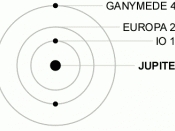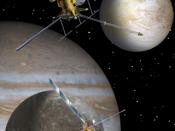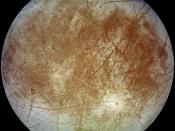Europa
Manzhen Chen
4.20.2010
Period 4
Europa is a moon of Jupiter. Europa was discovered by Galileo Galiei in 1610, along with three other moons: Io, Ganymede, and Callisto. Together, they are known as the Galilean Moons. Europa, like the other Galilean satellites, was named after a lover of Zeus. Europa, in Greek mythology, was a princess who Zeus saw gathering flowers and fell in love with. Her symbol is the white bull, or the Taurus constellation in the sky.
Europa's surface has one of the smoothest bodies in the solar system and is rather young. It has a crust of ice, up to ten km thick. Scientists believe that under the layer of ice, there is an ocean of liquid water, around 100 km thick. That would be nearly two times as much water as there is on Earth. It is believed that Europa there is a rocky layer that surrounds the metallic iron core.
Europa's atmosphere is composed of molecule oxygen. In 1997, the Galileo probe confirmed that there was a weak ionosphere around Europa, created by solar radiation and active particles from Jupiter's magnetosphere, providing evidence of an atmosphere. Europa's surface pressure is barely one hundred billionth that of the Earth's. Its icy surface is exposed to sunlight and is impacted by dust and charged particles of Jupiter's powerful magnetic field. Water vapor and gaseous pieces of water molecules would be made because of the combined processes. After the gas particles are made, they go through a process of chemical reactions that form hydrogen and oxygen molecules. The lighter hydrogen pieces escape into space while the heavier oxygen pieces build up to from an atmosphere of about 200 km above the surface. The oxygen gas slowly leaks into the atmosphere and is replaced.
Europa has nearly...


